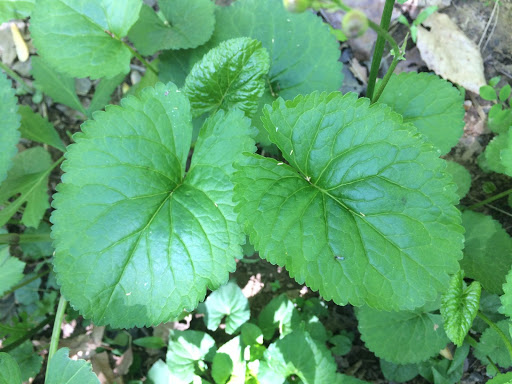Native Plant Profile: Golden Ragwort (Packera aurea)
Golden ragwort (Packera aurea) brings forth a burst of yellow color in spring gardens. It is part of the aster family (Asteraceae). This semi-evergreen wildflower can aggressively spread and can function as a natural groundcover for woodland gardens. It can also assist with some erosion control.
The daisy-like flowers of golden ragwort bloom in April through early May in much of Maryland. This perennial wildflower can sometimes achieve heights up to two feet. It grows in a clumping habit and has large, basal leaves that are heart-shaped. Stem leaves are minimal but alternate. The underside of the basal leaves sometimes host a tinge of purple, making this plant even more endearing.
Golden ragwort can grow in part to full shade and even in full sun. It prefers moist to wet soil with average pH. As the conditions get sunnier, golden ragwort requires more moisture in the soil.
This plant provides both nectar and pollen for visiting pollinators that include little carpenter bees (Ceratina spp.), cuckoo bees (Nomada spp.), and various sweat bees. Several types of pollinating flies, including syrphid flies, will also visit golden ragwort. Occasionally, leaf miners will leave their characteristic squiggly feeding lines in the leaves, but this is mostly a cosmetic issue and not one to worry about. Luckily enough, white-tailed deer do not prefer the foliage of golden ragwort and often leave it alone due to the low toxicity alkaloid (Pyrrolizidine) in its leaves.
Consider adding golden ragwort as a pop of spring color to your yard that also helps local pollinators!
References:
Illinois Wildflowers. Golden ragwort. https://www.illinoiswildflowers.info/woodland/plants/gold_ragwort.htm Accessed April 13 2021.
USDA, NRCS. 2020. The PLANTS Database (https://www.nrcs.usda.gov/Internet/FSE_PLANTMATERIALS/publications/mdpmcfs8097.pdf). National Plant Data Team, Greensboro, NC 27401-4901 USA. Accessed April 14, 2021.
Happy Spring HabiChat fans!
After what seems like the longest winter, I am happy to see signs of spring popping up in my local landscape. The queen bumblebees have emerged from their winter slumber. The ruby-throated hummingbirds are beginning to migrate back to Maryland. The trees are all starting to leaf out. So much is happening right now!
One big event slated for Maryland this year is the emergence of Brood X, the 17 year periodical cicadas. Learn more about these fascinating critters, what to expect, and their benefits with this season’s article on cicadas.
Spring is also a great time to add native plants to your garden! This edition of Habichat features golden ragwort, a native perennial which lights up gardens with a pop of yellow this time of year. Check out the Maryland Native Plant Society website for a list of local nurseries that supply native plants. This time of year is also a great one to tackle some of the invasive plants that may have found their way into your yard. Check out the Plant Invaders of Mid-Atlantic Natural Areas for information on common invaders and how to properly remove them.
This edition of HabiChat also includes an article on how to make your backyard owl friendly as well as a few new backyard books for 2021 and small blurbs on young wildlife in the garden and the current salmonella outbreak with feeders.
Finally, don’t forget to check out our Wild Acres webinar series. Each month, we feature different topics relating to Maryland’s wildlife and natural resources. In June, we’ll have guest speakers from the University of Maryland Extension and Calvert County to speak on topics such as forest succession and American kestrels.
Happy Habitats,
Kerry Wixted
Click here to have HabiChat—the quarterly backyard wildlife habitat newsletter from the Wild Acres program—delivered right to your inbox!
In this Issue
Native Animal Profile: Brood X Periodical Cicadas
Habitat Tips: Owl-Friendly Backyards
Backyard Books Review
Backyard Blurbs




